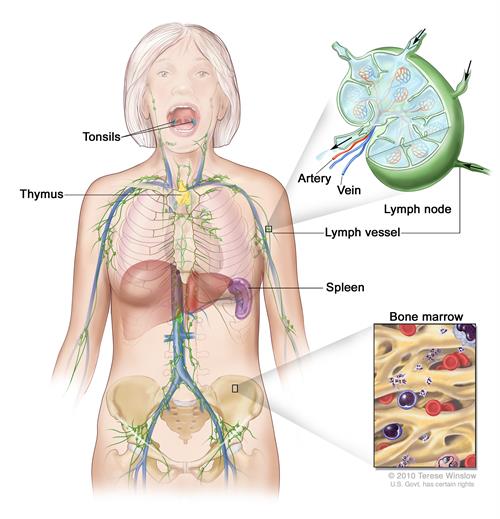PDF chapter test TRY NOW
The lymphatic system comprises lymphatic capillaries, lymph nodes, lymphatic vessels, and lymphatic ducts. The fluid that flows through the lymphatic system is known as lymph. The lymphatic capillaries unite to form large lymphatic vessels.
Lymph nodes are small oval or pear-shaped structures found along the length of lymphatic vessels.

Lymphatic system and lymphatic organs
What is lymph?
Like blood, lymph is also a connective tissue which is also called tissue fluid. Lymph from the intercellular spaces drains into lymphatic capillaries. The organs that secrete lymph are known as lymphoid organs. Lymph nodes, tonsils, spleen, thymus gland includes the lymphoid organ.
Important!
The spleen is the largest lymphoid organ present in the body.
Lymph is formed when some plasma, proteins and lymphocytes escape into the intracellular spaces in tissues through the pores present in the capillary walls. It is a colourless fluid that constitutes lymph plasma and lymph corpuscles.
The lymph plasma is similar to the blood plasma but is colourless and has fewer blood proteins and high glucose concentration. The lymph corpuscles include the leucocytes, which are mostly lymphocytes. RBCs and platelets are absent in lymph. The lymph contains a very small amount of oxygen, \(CO_2\), nutrients, water and WBCs.
Functions of Lymph:
1. Carries nutrients and \(O_2\) to the parts where blood cannot reach.
2. It drains the excess tissue fluid and metabolites. It also returns the proteins to the blood from the tissue spaces.
3. Lymphatic capillaries of intestinal villi (lacteals) helps in the absorption of digested fats. The lymph also carries absorbed fat from the small intestine. It drains the excess fluid from the extracellular space back into the blood.
4. The WBCs present in the lymph aids in the defence mechanism, repair and healing of tissues.
Reference:
https://www.flickr.com/photos/nihgov/28876155584
